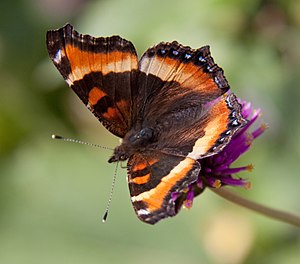Aglais milberti
| Aglais milberti | ||||||||||||
|---|---|---|---|---|---|---|---|---|---|---|---|---|

Aglais milberti |
||||||||||||
| Systematics | ||||||||||||
|
||||||||||||
| Scientific name | ||||||||||||
| Aglais milberti | ||||||||||||
| ( Godart , 1819) |
Aglais milberti ( Syn .: Nymphalis milberti ) is a butterfly (day butterfly ) fromthe noble butterfly family (Nymphalidae). The epithet honors the French natural scientist Jacques-Gérard Milbert .
features
butterfly
The wingspan of the moth is 42 to 63 millimeters. The outer edge of the wing is jagged. The basic color of the top of all wings shows a dichotomy. The basal and disk regions are black-brown, the post-disk and submarginal regions are orange-yellow to orange-red. There are two orange-brown spots at the front edge of the disk region, a black-brown spot in the post-disk region and a light blue spot near the apex . The edge of both pairs of wings is dark brown and filled with blue spots on the hind wings. The underside of the wing shows an alternating dark and light brown base color, there are no colorful drawing elements.
Egg, caterpillar, pupa
The pale yellow egg is ribbed. Adult caterpillars are black, finely spotted with white and have yellow side lines, reddish spots, yellowish hairs and blackish thorns. The fall doll is usually light brown in color, has a golden shimmer and has a point on the back and two on the head. Occasionally there are almost black pupae.
Distribution and occurrence
The range of the species covers a wide belt of the central and northern states of the USA as well as large parts of Canada . In Colorado, the moths also migrate to higher mountainous areas, where they do not reproduce because there are no food plants there. Aglais milberti prefers to colonize open, partly swampy terrain and forest edges.
Way of life
The moths fly for one to three generations per year, depending on the climatic conditions. The last of these hibernates as a moth. They fly quickly in the sunshine, suck nectar from blossoms, sometimes tree sap and like to rest on stony ground. The females lay several hundred eggs in groups on the underside of the leaves of the food plant. Young caterpillars initially live gregariously in a spun, nest-like structure at the top of the food plant. Adult caterpillars live solitary and sometimes hide in a rolled and spun leaf. They feed on the nettle family (Urticaceae).
Subspecies
In addition to the nominate form Aglais milberti milberti , the following subspecies are distinguished:
- Aglais milberti furcillata
- Aglais milberti pullum
- Aglais milberti viola
supporting documents
Individual evidence
- ↑ Washington Butterfly Association ( page no longer available , search in web archives ) Info: The link was automatically marked as defective. Please check the link according to the instructions and then remove this notice. (PDF; 1.5 MB)
- ↑ butterfliesandmoths.org
- ↑ www.buglifecycle.com
- ↑ a b c d e James A. Scott: The butterflies of North America. Stanford University Press, Stanford, California 1986, ISBN 0-8047-1205-0
literature
- James A. Scott: The butterflies of North America. Stanford University Press, Stanford, California 1986, ISBN 0-8047-1205-0
Web links
- eol.org Encyclopedia of Life
- www.nic.funet.fi dissemination

